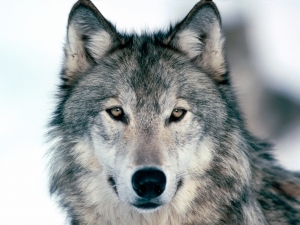 Canis Familiaris also know as the domestic dog has been granted with the title of Man’s Best Friend, but how did this relationship began?
Canis Familiaris also know as the domestic dog has been granted with the title of Man’s Best Friend, but how did this relationship began?
Anthropological evidence points to the early Stone Age as being a critical point for human-animal symbiotic relationships, the hunter and gathering nomadic human tribes began to settle in their own niche’s, settling the land so to speak. As hunters the early people most likely learned how to hunt efficiently by observing other predators hunt in their natural environments, it would be safe to assume that early wolves, and their method of hunting, were a model that early humankind mimicked.
The story of human interaction with wolves dates back 12,000 years. (Darcy F. Morey) Wolves and humans being social, cunning, and hunters naturally gravitated towards one another in similar environments and niches in the ecosystem. The style and similarities in wolf packs and human tribes are strikingly similar being hierarchical in nature, which would allow for a future complimentary relationship in regards to respect and socialization. So how did wolves become dogs?
The most accepted theory regarding how wolves became domesticated was proposed by Raymond Coppinger,
“Wolves became domesticated dogs by carving out a niche for themselves in the dumps of human settlements. He proposes that when humans gave up their nomadic lifestyle and began to gather in human settlements, a new ecological niche was created in the dumps of these human settlements. Wolves that had a higher “flight distance” tolerance would avoid these dumps, or spend more time and energy running away from the dumps when people approached than they would scavenging. Wolves with a lower “flight distance” would not startle and run from humans as easily, and this would allow them to eat more and succeed in this new niche. This flight distance gene would be passed on to future generations, with the tamer wolves propecia online in canada having more success in the new environment. Over time, the wolves would develop a shape more suited to scavenging, with a smaller body and smaller brain, which would require less energy. Coppinger uses evidence of domestic dogs found in dumps in societies around the world to support his theory.” (Coppinger, 2001)

Available for Adoption 9/15/2015
The implication for such a theory is that man’s best friend is a direct effect of our settling into a sedentary lifestyle. Civilization is a direct effect of humankind settling into towns, villages and eventually cities and archeological evidence indicates that the dog was the first species of animal to be domesticated and that this occurred towards the end of the last Ice Age when all human subsistence still depended on hunting, gathering and foraging. (Serpell, 1995) Dogs, it can be said, were domesticated solely for companionship, a kindred spirit and later grew to take on several roles associated with learning new behaviors that allowed for greater survival among humans. Wolves have observed humans, humans had observed wolves both opportunists and both trying to survive in a wild world, out of this dynamic came man’s best friend. (Monique A.R. Udell, C.D.L. Wynne)
In modern times the human race has come a long way and so has our companion the dog, whose wild ancestor still roams the savage lands of this earth and still observes us as both friend and foe. The story of man’s best friends is by no means simple and it spans thousands upon thousands of years that requires imagination and lofty thought experiments as to how and why man and wolf has become man and dog.
